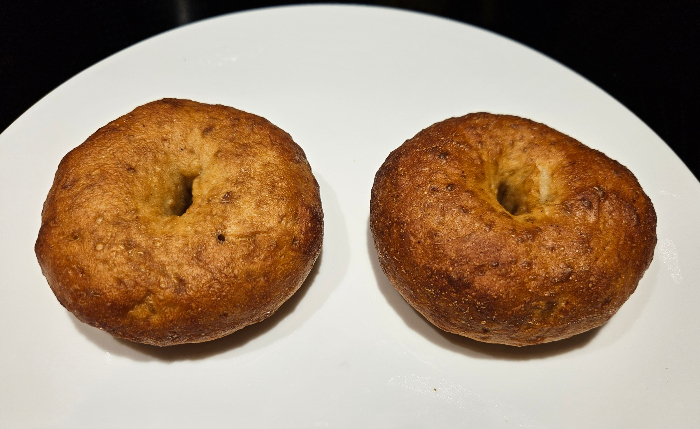The Bagel Desert is no More
April 10th, 2025Oy
I may have cracked the bagel code.
I can’t figure out why I can’t just go to Google, type “bagel recipe,” and get an obvious answer millions of bakers should already know. But I can’t. It’s like Googling Mormon secret handshakes, only harder, because you can actually find Mormon secret handshakes pretty easily online. Here they are.
I knew high-hydration recipes were stupid, because anyone who has ever eaten a bagel knows they are dense and a bit dry. The King Arthur company recommends 63%, which is nearly wet enough for pizza. The longer I live, the more certain I am that no one at that company knows anything about actual cooking. Recommending 63% hydration in a bagel is like recommending cottage cheese in cheesecake.
Tonight I went back to the recipe I started on a few months ago. The hydration is 55%. I reduced the yeast. Other than that, no changes. I made the dough in a Cuisinart, let it rise for about three hours, rolled out 4 bagels, tested them for proofing by seeing if they floated in water, boiled them for two minutes per side in a special solution, and baked them at 400°.
They were not exactly like New York bagels. They were smaller, for one thing. My bagels started out at around 92 grams, and I plan to move up to 125. They also tasted a little different on the outside. They had kind of a baking soda taste in addition to malt and sweetness.
They were not precisely on target, but they were better than the bagels I get at the store even though the store bagels are pretty much exactly what a New York bagel is supposed to be. The odd flavor from the solution made the bagels taste different, in a good way. My wife likes them better than store bagels. Nonetheless, I plan to move back toward the original taste next time. Here is what I plan to do:
INGREDIENTS
240 grams high-gluten flour (not bread flour)
132 grams warm water
1 tsp. salt
1 tbsp. diastatic malt powder
132 g warm water
1/4 tsp. instant yeast
Water Bath
1 qt. water
4 tbsp. dried malt extract (not diastatic)
1/2 tsp. salt
1/2 tsp. baking soda
I will cut the baking soda from 1 teaspoon to 1/2 because I could taste the soda in the bagels I ate. That seems like overkill. The baking soda is supposed to improve the crust, so I will see if I really need a whole teaspoon.
I made 4 dough balls and put them under a glass bowl to rise. I mashed them into disks and put holes in them and let them rise some more. I dumped one into cool water to see if it had risen enough. It floated, so I assumed all was well.
I didn’t make the bagels the old-fashioned way, rolling dough into strips, wrapping them around my hands, and rolling them forward and back until they made rings. That’s a pain. I just poked holes in my circles and stretched them. The result is more uniform and less likely to produce faulty bagels. It’s better.
The holes closed up more than I wanted, but it worked out, because when bagels have big holes, food falls through them.
At this stage, you boil your bagels two minutes per side. I drained mine on paper towels, figuring baking them sitting in water was a bad idea. I baked them at 400° on an air bake sheet with a piece of nonstick foil on it.
At 20 minutes, they were dark, but not too dark.
They are crusty and chewy. The texture seems fine to me. Even if I never get the exact flavor New York bagels have, these will be very nice with smoked salmon and cream cheese. As good or better than classic bagels.
Once I’m content with the recipe, I’ll figure out how to make garlic bagels, which are THE correct bagels to eat with salmon, regardless of what a lot of unimportant people think.
This is great. I no longer have to rush to Publix early in the day, hoping retirees with names like Morty, Sol, and Moishe haven’t snapped up all the plain bagels. And soon I’ll be able to get garlic bagels, which are better.
See you at breakfast.
